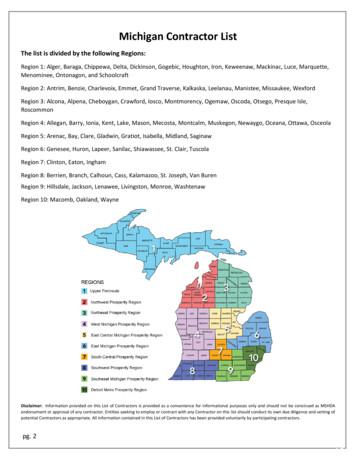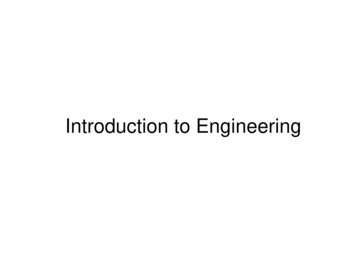Analysis Of Mechanical And Physical Properties On Geotextiles After .
Lodi, P.C., Bueno, B.S., Zornberg, J.G., and Correia, N.S. (2008). “Analysis of Mechanical and Physical Properties on Geotextiles after Weathering Exposure.”Fourth European Geosynthetics Conference, EuroGeo4, Edinburgh, United Kingdom, 8-10 September, pp. 1-6 (CD-ROM).EuroGeo4 Paper number 203ANALYSIS OF MECHANICAL AND PHYSICAL PROPERTIES ON GEOTEXTILES AFTERWEATHERING EXPOSUREPaulo César Lodi1, Benedito De Souza Bueno2, Jorge Gabriel Zornberg3 & Natália De Souza Correia41São Paulo State University (UNESP) at Ilha Solteira. (e-mail: plodi@dec.feis.unesp.br)University of State of São Paulo (USP) at São Carlos. (e-mail: bsbueno@sc.usp.br)3University of Texas at Austin. (e-mail: zornberg@mail.utexas.edu)4University of State of São Paulo (USP) at São Carlos. (e-mail: nataliacorreia@uol.com.br)2Abstract: When geotextiles are exposed to solar rays for a short or long period of time, some level of UVdegradation occurs. In this sense, variations in physical and mechanical properties may occur due to degradation byoutdoor exposure. This paper presents results of mechanical and physical properties on 3 polyester PET non-wovengeotextiles that were exposed to weathering for 720 and 1440 hours (1 and 2 months). Properties were evaluatedaccording to the Brazilian standards (NBR). The results showed that the geotextiles presented some variations intensile properties after exposure. Deformability decreases after all times of exposure. The samples became stiffer thanfresh samples.Keywords: geotextile, weathering, laboratory tests.INTRODUCTIONGeotextiles (GT) may be exposed to UV radiation in many different ways. The time of exposure may cause somelevel of degradation on the materials since all the geosynthetics contain polymers in their formulation. All thegeotextiles are sensitive to UV effects. Loss of properties (tensile resistance and deformability, for example) mayoccur in prolonged exposure. Generally, the polyester (PET) shows medium to good UV resistance. Thus, evaluationof the effects of outdoor exposure is very important.The ASTM D5970 procedure is commonly used as a guide to evaluate geotextile products for outdoor exposure.Because, in outdoor testing, the effects of sunlight can take an extended period of time to become apparent, anaccelerated method is desirable. Many methods of accelerated weathering of geotextiles are available (Baker 1997).This paper presents results of mechanical and physical properties of 3 PET non-woven geotextiles (171, 280 and450 g/m2) that were exposed to weathering for 1 and 2 months. Properties were evaluated according to the Brazilianstandards (NBR).MATERIAL AND METHODSNon-woven geotextiles (GT) were exposed according to ASTM D1435 and D5970. Samples were placed on apanel located in the east-west axis angled towards the sun (Figure 1). Three Polyester (PET) non-woven geotextileswere exposed and evaluated: 171, 280 and 450 (g/m2). These will be referred to as PET 171, PET 280 and PET 450.The PET geotextiles were exposed for a total period of 2 months. Physical and tensile properties were evaluated andcompared to intact (un-exposed) material. Tests were carried out in accordance with ABNT standards (Brazilstandards): ABNT NBR 12568 (mass per unit area) and ABNT NBR 12824 (tensile properties).Figure 1. PET non-woven geotextile samples exposed to weathering1
EuroGeo4 Paper number 203RESULTS AND DISCUSSIONDuring the periods of exposure, the average values recorded were 26 C (temperature), 59 mm (precipitation), 65%(relative humidity), and 0.9 (MJ/m2)/day (intensity of global radiation). The cumulative UV radiation until the end ofthe period of exposure is about 52.10 (MJ/m2).Table 1 compares the results obtained for all 3 PET geotextiles (intact and after exposure). Table 2 shows the UVradiation values obtained during outdoor exposure.Values of mass per unit area are presented in Figure 2. Figures 3 and 4 show the variations that occurred in tensileresistance and deformation versus the cumulative UV radiation.Table 1. Comparison of results of properties obtained for PET non-woven geotextilesTensileMass perStrengthCV* (%)Elongation (%)Geotextile Condition unit area CV* (%)(kN/m)(g/m2)MDCMDMDCMDMDCMDPET 171PET 280PET 450CV* 976.781 month1507.003.695.7415.808.5774.0965.016.783.922 tact2809.8810.212.839.5513.776.1082.215.404.701 month2009.005.365.325.704.5648.5553.079.091.932 012.118.522.0612.037.6171.1474.895.857.071 month50012.020.420.298.766.1359.5960.083.795.582 .39* CV Coefficient of variation; MD longitudinal or machine direction; CMD transverse or cross machine directionTable 2. UV radiation MJ/m2)/day0.000.920.79(MJ/m2) (cumulated)0.0027.6052.09All of the geotextiles presented variations in mass per unit area after exposure. PET 280 presented the highestdecrease (28.57%) after 1 and 2 months of exposure. PET 171 presented a variation of 12.28% (decrease). Thesevariations in mass per unit area occur due to two main factors. The first factor is related to the loss of mass of thematerial when exposed to the solar rays: loss of antioxidants and carbon black. These additives have the function toimprove the resistance to rays UV and to protect the material in case of exposure. Secondly, the geotextiles have ainherent variability in the mass per unit area due to the manufacturing process. Rigorous controls are required inselecting specimens for the tests so that this factor does not mask the apparent effects of UV exposure. Prior toweighing, the specimens were conditioned to the standard temperature and humidityPET 171, 280 and 450 geotextiles all presented variations in the tensile strength. After the first month of ageing,one geotextile presented an increase in the value of the tensile strength: PET 450 (10.41%) in the MD (longitudinaldirection). Note, however, that the mass of this sample appeared to increase and so it is probable that this result is ananomaly of the sampling. At the last period, all geotextiles presented a reduction of the tensile strength in the twodirections. Some tensile strength reductions were more significant in the CMD (transverse direction) as, for example,PET 171 after 2 months (43.46%), PET 280 after 1 month (58.53%) and 2 months (52.07%). Analysing the averagecurves for both MD and CMD directions, it is observed that the trend of the behaviour of the tensile strength ischaracterised by decreases (eliminating the dubious result for the PET 450),The deformability presented also decreased after two periods of exposure. After the final period, the reductionreached values of about 40% for PET 171 and 280 in the both directions. The largest variation for PET 450 occurredafter the last period: decrease of about 30% in the MD (longitudinal direction). The average curves of deformationshow decreases of the deformability after the exposure periods.2
EuroGeo4 Paper number 203LABORATORY METHODS FOR ACCELERATED TESTINGAccording Baker (1997), to evaluate the effects of sunlight in outdoor testing, an accelerated method is desirable.During the 2 two month duration of this research, the cumulative UV radiation to the final exposure time is 52.10(MJ/m2)/month. It is proposed to consider the equivalent exposure that can be obtained in the laboratory. Thelaboratory weatherometer equipment in common use is the xenon arc lamp and the UV-A lampsThe radiant exposure in the UV range can be calculated by integration of the light energy for the wavelengths from295 to 385 nm (xenon arc lamps) and 295-400 nm (UV-A lamps). The UV irradiance from 295-385 nm is 28.9Watts/m2 (total energy) and the UV irradiance from 295-400 nm is 39 Watts/m2 (energy total). The representativespectral power distribution of xenon arc lamps and UV-A lamps may be found in ASTM G154.By use of the above, is possible to evaluate the time necessary to achieve the UV radiance in a UV weatherometer.For example, using an arc xenon lamp the energy total required is 28.9 W/m2. The energy level reached in thisresearch is equal to 52.10 MJ/m2. The time in a UV weatherometer (xenon arc lamp) is:Time (xenon arc) 52.10 x 1x 106 W.s/m2 / 28.9 W/m2 500.77 hours 20.86 days.Using a UV test device programmed with an eight-hour UV cycle followed by a four-hour condensation cycle, thetotal energy generated is:8 h (28800 s) x 28.9 W/m2 0.832 MJ/m2. The number of cycles to obtain the energy is: 52.10 / 0.832 62 cycles.The total experimental time is: 63 x 8 (UV) 63 x 4 (condensation) 756 hours. Thus, the test device needs 756hours testing time to obtain 52.10 MJ/m2. Similarly, using a UV-A lamp the time total using the test device is 564hours. Remember that the UV radiation is generated only during the eight-hour cycle.Mass per unit area x timePET 1712Mass per unit area (g/m )600PET 280PET ime (months)(a)Percentage Variation - Mass per unit areaPET 17115PET 28011,11Mass per unit area (%)10PET 45050 0-5 5Time (months)(b)Figure 2. Variation of mass per unit area verses time (a) g/m2 (b) percentage variation3
EuroGeo4 Paper number 203Tensile resistance (%)PET 17112010080PET 171L60PET 171TAverage4020001020304050602Cumulative UV Radiation (MJ/m )Tensile resistance (%)PET 28012010080PET 280L60PET 280TAverage4020001020304050602Cumulative UV Radiation (MJ/m )Tensile resistance (%)PET 45012010080PET 450L60PET 450LAverage40200010203040502Cumulative UV Radiation (MJ/m )Figure 3. Variation of tensile resistance verses cumulative UV radiation460
EuroGeo4 Paper number 203PET 171Deformation (%)12010080PET 171L60PET 171TAverage4020001020304050602Cumulative UV Radiation (MJ/m )PET 280Deformation (%)12010080PET 280L60PET 280TAverage4020001020304050602Cumulative UV Radiation (MJ/m )PET 450Deformation (%)12010080PET 450L60PET 450LAverage4020001020304050602Cumulative UV Radiation (MJ/m )Figure 4. Variation of deformation verses cumulative UV radiationCONCLUSIONSResults of tensile properties and mass per unit area for non-woven PET geotextiles (171, 280 and 450 g/m2)exposed to weathering for 1 and 2 months were presented. After the exposure periods, some changes occurred in massper unit area and in tensile properties. The samples showed a general reduction in mass with exposure.Tensile resistance presented a trend of reduction verses time. The same behaviour was observed concerning thedeformation. The samples became stiffer than fresh samples.The cumulative UV radiation may be useful when an accelerated method is desirable. Some examples werepresented and the cumulative UV radiation equivalence obtained by calculating the time necessary to achieve the UVradiance in a UV weatherometer using arc xenon and UV-A lamps.5
EuroGeo4 Paper number 203Corresponding author: Prof Paulo César Lodi, São Paulo State University (UNESP) at Ilha Solteira, AlamedaBahia, 550 - Centro, Ilha Solteira, São Paulo, 15385000, Brazil. Tel: ( 55) 18 3743 1217. Email:plodi@dec.feis.unesp.br.REFERENCESABNT NBR 12568. Geosynthetics. Determination of mass per unit area, Brazilian Association of Technical Standard,Brazil (in Portuguese).ABNT NBR 12824. Geotextiles. Determination of non-confined tensile – wide strip test, Brazilian Association ofTechnical Standard, Brazil (in Portuguese).ASTM D 1435. Standard Practice for Outdoor Weathering Plastics, American Society for Testing and Materials, WestConshohocken, Pennsylvania, USA.ASTM D 5970. Standard Practice for Deterioration of Geotextiles from Outdoor Exposure. American Society forTesting and Materials, West Conshohocken, Pennsylvania, USA.ASTM G 154 Standard Practice for Operating Fluorescent Light Apparatus for Exposure of Nonmetallic Materials,American Society for Testing and Materials, West Conshohocken, Pennsylvania, USA.Baker, T.I., 1997. Long-term relationship of outdoor exposure to Xenon-Arc test apparatus. Proceedings of theGeosynthetics ’97, IFAI, St. Paul, MN, pp. 177–199.6
degradation occurs. In this sense, variations in physical and mechanical properties may occur due to degradation by outdoor exposure. This paper presents results of mechanical and physical properties on 3 polyester PET non-woven geotextiles that were exposed to weathering for 720 and 1440 hours (1 and 2 months). Properties were evaluated
Mechanical Contractor Redmon Heating & Cooling Grandville (616) 534-9330 Mechanical Contractor D.K.S. Mechanical, Inc. Marne (616) 677-6001 Mechanical Contractor AirFlow Mechanical Services LLC Wyoming (616) 752-0320 Mechanical Contractor Van Antwerp's Mechanical, Inc. Holland (616) 772-1112 Mechanical Contractor Grand Rapids Heating and .
The Mechanical Foundation Series is a compulsory basic course for mechanical majors. It covers a wide range of courses, including mechanical drawing, mechanical principles, mechanical design, mechanical manufacturing foundation, engineering materials and tolerance technology measurement [1]. It is a learning
physical education curriculum table of contents acknowledgements 2 district mission statement 3 physical education department mission statement 3 physical education task force 3 physical education and academic performance 4 naspe learning standards 8 new york state physical education learning standards 8 physical education high school curriculum guide 15 physical education curriculum analysis .
for mechanical engineers in tamilnadu, list of government jobs for mechanical engineers in karnataka, list of government jobs for diploma mechanical engineer, list of govt jobs for mechanical engineers T), MCA, Electronics and Communication (ECE), Mechanical, Electrical and . l Design automation -
Mechanical analysis The results of the analysis of the control rod drive mechanism on the Chain and Sprocket suitable are shown in Table 1. This mechanical analysis is very important since the change in the process condition gives impacts on the mechanical properties [16, 17]. Von-misses stress occurring in the chain is 409.51 MPa, and
Mechanical Engineering Aerodynamic Design of Vehicles Compute Aided Analysis & Design Analysis & Design. Mechanical Engineering Wind Energy Fuel Cell Energy. Mechanical Engineering UAV Space Shuttle Air & Space. Mechanical Engineering Robotics Utilities Systems. Civil Engineering Foundation Structural Analysis Analysis & Design. Civil Engineering Bridge Skyscraper Tunnel Construction . Civil .
1. Know the importance of physical fitness. 2. Know the measures of physical fitness. 3. Know how to plan and execute a physical fitness plan. Samples of Behavior/Main Points: 1. Define physical fitness and explain the difference between physical activity and exercise. 2. Identify the benefits of physical activity. 3.
Keywords --- algae, o pen ponds, CNG, renewable, methane, anaerobic digestion. I. INTRODUCTION Algae are a diverse group of autotrophic organisms that are naturally growing and renewable. Algae are a good source of energy from which bio -fuel can be profitably extracted [1].Owing to the energy crisis and the fuel prices, we are in an urge to find an alternative fuel that is environmentally .






















